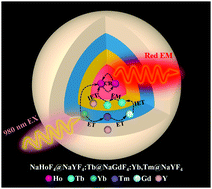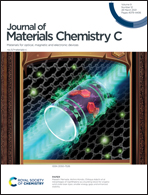Constructing a small core–multishell nanostructure for Ho-based red upconversion emission†
Abstract
The development of Ho-based red-emitting upconversion (UC) nanoparticles with small size is of great significance in scientific research and practical application. Besides, a time-saving and environment-friendly strategy for the synthesis of core–multishell UC nanoparticles is urgently needed. In this work, small NaHoF4@NaYF4:Tb@NaGdF4:Yb,Tm@NaYF4 core/shell/shell/shell nanoparticles were successfully prepared by a modified co-precipitation method, in which sequential growth of shells could be realized. By means of Tb3+-mediated interfacial energy transfer (IET) and energy migration (EM), a novel mechanism for Ho-based red UC emission is presented under the premise of a small core size and thin shell. In the system, Ho-based red dominant emission mainly comes from the cross-relaxation process among Ho3+, which is induced by IET from Tb3+ to Ho3+. The EM process among Tb3+ can facilitate efficient energy transport. Furthermore, a mouse experiment demonstrates the deep penetration of 980 nm excitation and Ho-based red dominant emission. This new type of Ho-based red-emitting core–multishell UC nanoparticles not only provides an in-depth understanding of the IET-mediated energy-managing strategy but also displays special advantages in biomedical applications.



 Please wait while we load your content...
Please wait while we load your content...